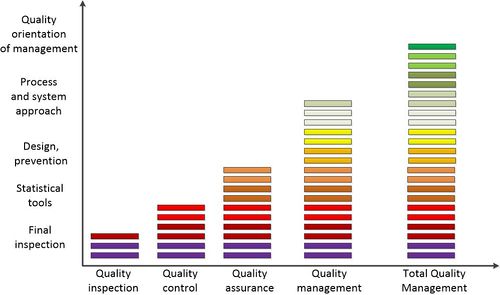Quality management
| Quality management |
|---|
| See also |
Quality management is an approach aimed at improvement of the efficiency and flexibility of all the organization in order to meet customer requirements, needs and expectations. It uses all management functions throughout the enterprise to achieve this. It is the fourth stage of quality approach evolution after: quality inspection, quality control and quality assurance.
Quality assurance vs. Quality management
Quality assurance is related to production (or services), product and technology design. It's aimed at delivering good product to the customer, that will fulfil customer's requirements and needs. It uses double feedback loop, which enables self-improvement of product, process and production system.
Quality management makes a step forward. As every activity in the company can impact the quality of the product, it covers whole enterprise, every function. In quality management every employee in the company should strive to improve quality of his/her work. That is especially visible in Total Quality Management.
Principles of quality management
The quality management principles were defined in ISO 9001 standard. They bring closer the normative approach (ISO standards) to Total Quality Management. In the first version, there were 8 quality principles, but the ISO 9001:2015 removes one of them leaving 7. Those principles are:
- Customer focus
- Leadership
- Engagement of people (formerly Involvement of people)
- Process approach
- System approach to management (removed in ISO 9001:2015)
- Improvement (formerly Continual improvement)
- Evidence-based decision making (formerly Factual approach to decision making)
- Relationship management (formerly Mutual beneficial supplier relationships)
In parentheses principles from ISO 9000:2000 were presented.
Quality management approaches
According to D. Kroslid, quality movement developed into two schools[1]:
- Deterministic,
- Continuous improvement.
The developed in parallel, however since 2000 they started to penetrate each other. Examples are: Lean Six Sigma and current approach in ISO 9001 standard.
Deterministic approach
The deterministic approach to quality begins with:
- Frederick Winslow Taylor,
- ideas of standardization in American defense industry and
- Crosby's Zero defects idea.
Standards, procedures, specifications and their exact fulfilment are the main principles. Therefore, managers are mainly responsible for quality improvement. Current approaches based on this approach are ISO 9000 standards family (especially before 2000 issue) and Six sigma. This approach usually ignores economic dimension of quality (quality costs, quality levels, profitability of quality focus).
Continuous improvement approach
The continuous improvement approach stems from
- statistical process control by Walter A. Shewhart,
- Total Quality Control by Armand Feigenbaum and
- Japanese Company-Wide Quality Control.
The main direction of pro-quality activities is fulfilment of ever changing needs and requirements of customer. Quality is understood as dynamic process. The continuous improvement and low costs is more important than non-changing level of high quality. Economic dimension of quality is important, especially through quality costs. Current approaches based on this approach are: Total Quality Management and Lean management.
Related methods
As the number of methods related to quality management is really large, please see category page, which contains their alphabetic list: Category:Quality methods and techniques.
References
- ↑ Kroslid D., Searching for Total Quality Management – Rethinking and Reinterpreting, Linköping Institute of Technology, Linköping 1999
- Juran J.M., De Feo J.A., Juran's Quality Handbook, Sixth Edition, McGraw Hill, 2010
- Tague N.R., The Quality Toolbox, Second Edition, ASQ Quality Press, 2013
- Flynn BB, Schroede RG (1995) The Impact of Quality Management Practices on Performance and Competitive Advantage, A Journal of the Decision Sciences Institute, 26:5
- Masood A. Badri, Donald Davis, Donna Davis, (1995) A study of measuring the critical factors of quality management, International Journal of Quality & Reliability Management, Vol. 12 Iss: 2
Author: Slawomir Wawak
